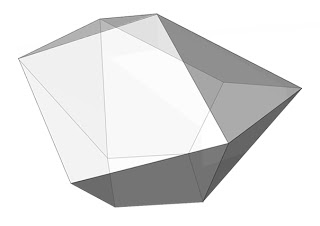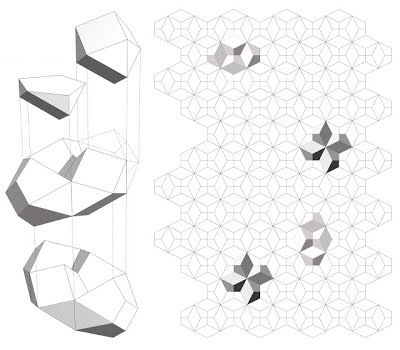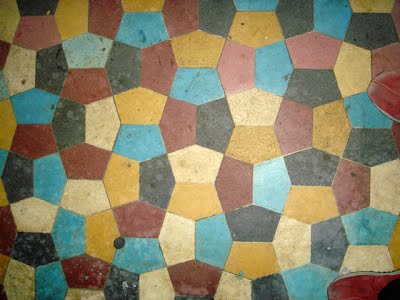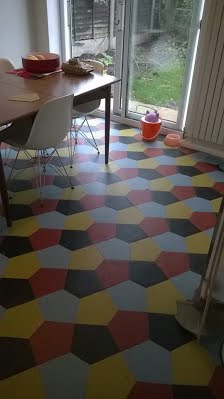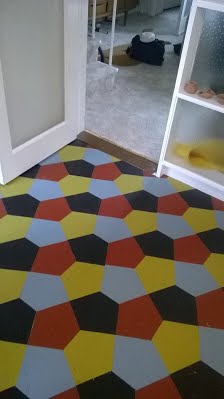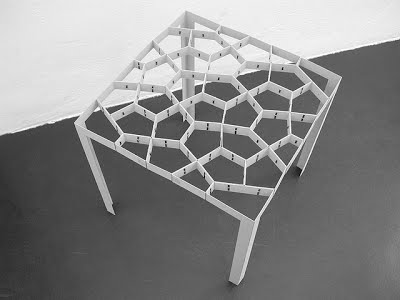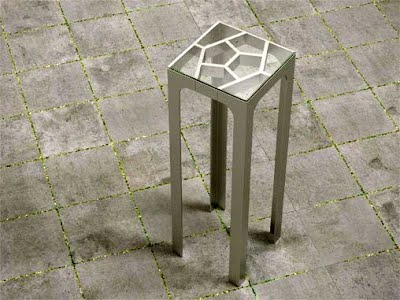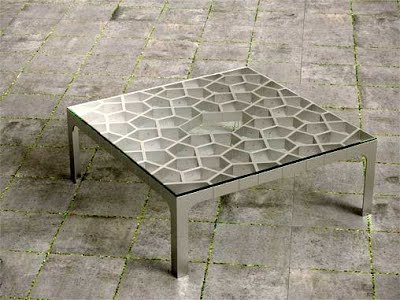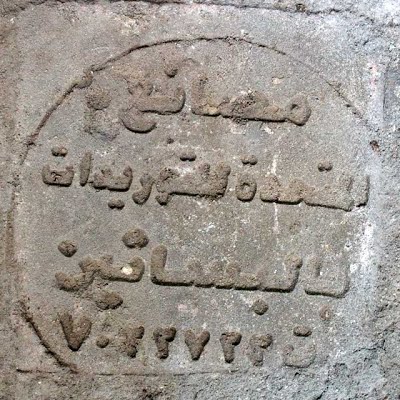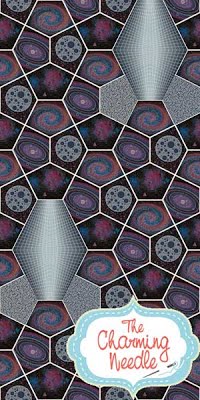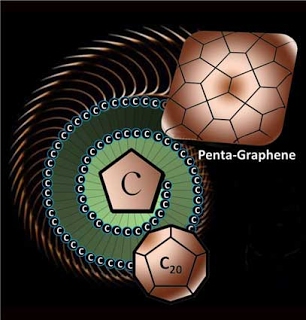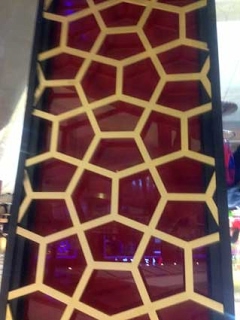A miscellaneous collection of various Cairo aspects, generally individually of a less substantial nature that with my other researches, and so for the sake of a more succinct listing, of which the Cairo section is by far the most numerous, I thus in effect amalgamate disparate elements: 1. Attraction 2. Bisymmetric Hendecahedron 3. Flooring 4. Furniture 5. Manufacturer 6. Quilting/Patchwork 1. Attraction An open question is just what is so ‘special’ about the Cairo pentagon tessellation that it attracts so much attention, both mathematical and non-mathematical (the latter in the form of actual street pavings), in contrast to other tilings that do not get such attention. Therefore, I thus address this issue of its attractiveness, and try and answer this query. Note that here I use the term ‘Cairo’generically, to refer to both types of pentagon, namely the ‘equilateral’ and ‘dual of 32. 4. 3. 4’, as generally distinctions are not made between the types. For the sake of brevity, these are referred to as ‘equilateral’ and ‘dual’ below. Contributions are sought from 'other people'. Mathematicians' Interest Mathematicians have long been interested in this as a tiling per se, even before the Cairo attribute, such as with P. A. MacMahon, in New Mathematical Pastimes, dating back to at least 1921 (the earliest discussion I can find), and H. M. Cundy and A. P. Rollett, Mathematical Models, 1951, to give but just two of the most prominent examples. Likely, the reason for this is that it has many interesting properties. Perhaps of most note is in the interpretation, in that a‘secondary’ grid of par hexagons is formed, overlapping at right angles to each other, of which I detail below. Further interest is in the two types, in that one can transpose between them, as detailed in Macmillan. Additionally, this has been used decoratively, as a book cover (Coxeter’s Regular Complex Polytopes). M. C. Escher also used this in his work, with periodic drawings 131, 132, 133, 134. Non-mathematicians, such as paving companies have also used it, with examples as far apart as in England, Japan (see Hargittai, page 174), and Cairo (Dunn and Macmillan). Therefore, with such a diverse interest, it must consist of a little something ‘extra’, aside from an ordinary, ‘run-of-the-mill’tiling. Indeed, it has been much commented upon, and described in flowery terms by mathematicians, with: § This beautiful tessellation… (Gardner) § … special aesthetic appeal (Schattschneider) § … the tessellation is particularly pleasing to the eye (Macmillan) § The beautiful Cairo tessellation (Martin) § One particularly elegant tiling of the plane by pentagons (Singer) § The tessellation…is one of the most remarkable (MacMahon) Very few tilings are so described as above, and so just what is it about this tiling that attracts such descriptions? As such, I believe that there is no one single factor, but of combinations that conflate to give a specially aesthetic and interesting tiling:
Paving Interest Also of note is that this has been used for actual pavings, of which presumably this must have caught the manufacturer’s eye, and so presumably thought the tiling was of more interest than others. But again, other tilings aside from the commonly to be found squares and rectangles have also been used, and so the Cairo tiling in not unique in this, although it is certainly unusual, in that relatively few tilings have been produced as actual street pavings. Other People: By Bruce Bilney: The Cairo Pentagon Tiling is to my eye one of the most beautiful regular designs of all. Its proportions and layout are simple yet remarkable. Sets of four identical, attractively-proportioned, but slightly irregular pentagons form elongate hexagonal “lozenges”, which then tessellate in a robust arrangement, reminiscent of an art-deco design. The overall effect is nearly mesmerizing. It seems to me that it would make an ideal pattern for a faux-brick paving tiling. Summary From the above, the Cairo pentagon has no unique attributes. Therefore, I consider that it is more likely in that it appeals as it possesses all the features discussed above, something which other tilings lack. That said, I think the primary reason is in the‘overlapping’ of the par hexagons, which in combination consist of the four pentagons. Somehow, it seems an ‘unlikely’ situation, and so this catches the eye, with further aesthetic appeal provided by the apparent ‘regularity’ of the pentagons themselves. Furthermore, the pattern is visually ‘simple’, and so has immediate appeal, consisting of just one tile, with a ‘basic’ nature, either equilateral of dual, with one line of mirror symmetry. Contrast this simplicity with the typically more ‘involved’ Islamic patterns, where one could say that there is simply too much detail for the eye to take in, and so such tilings arguably lack elegance. Also, tilings based on pentagons per se somehow seem more ‘interesting’ than those of, say, triangles or quadrilaterals. Created 7 December 20102. Bisymmetric Hendecahedron Another curiosity of the Cairo tiling is that it can be seen in an instance of polyhedra, specifically of the space-filling Bisymmetric Hendecahedron. Such a polyhedron is a relatively recent discovery, as reported in a 1996 paper by Guy Inchbald. For further details see: http://www.steelpillow.com/polyhedra/five_sf/five.htm Although the Cairo tiling as an entity was not directly noticed in Inchbald’s paper, an architect, Jak Drinnan, happened to noticed this, and being familiar with the Cairotiling made the association. Although I am interested in polyhedra, this is very much secondary to my interest in tessellation. Indeed, I lack the mathematics here for a true mathematical treatment. Would any reader more familiar with this have anything to say? For more on Jak Drinnan and the bisymmetric hendecahedron per se, see: http://www.jd-d.co.uk/2012/07/material-designing-complexity.html3a. Flooring, Cairo Apartment
3b Flooring, UK, 1950s Style? Natural Floors © Natural Floors NW https://www.facebook.com/Natural.Floors?fref=ts 4. Furniture Some table designs as shown at design fairs, from Andreas Hopf, the designer. 5. Manufacturer An open question is to where the pavings were, and indeed likely still are, being produced and distributed. Details on this aspect are sketchy, to say the least. However, following information provided by a correspondent, Mohammed Elmokadem, he told me that these are made in small workshops in Basateen, Al Darb al Ahmar, and in Giza. However, these have not been found, some of the areas are either far from my two investigators, Pam Garnett and Gregg De Young to visit, or not suitable places to visit due to security concerns. Also, Mohammed told me that frequently details of the date are inscribed on the reverse side, and this had led to further detail, thanks to the ‘in the field’ investigations of Pam in examining the reverse side of a square format loose tile, as shown below. This shows not the date, but the place of manufacture, which translates as it being made in the district of Basateen, with the ‘Basateen United supply company’, New Maadi, but here the investigation has come to a stop, as Pam has not been able to find the company, despite having a street address upon Googling the above reference; the shop there present knows nothing of this; possibly they have moved. However, this at least provides a lead. Does anyone know of this company? Also, following correspondence with Laëtitia Huré, general secretary to the manager of the Old Cataract Hotel in Aswan, there is a report of it being made in Aswan, 450 miles away from Cairo, who told me that upon asking the staff, it is made in ‘small factories in Aswan’. However, she was not able to be more specific than this. This report is certainly interesting. Upon reflection, it would appear that rather than ordering these directly from Cairo, with all the costs arising from such a far distance, one can readily imagine that these would be made local. Therefore, they could indeed be being made in a variety of locations, but if so, they have so far evaded detection! Does anyone know of these places? A problem in determining where the pavings are (or were) being made is one of culture. Egyptians, upon being asked a question, do not like to disappoint the interviewer, and tend to give what the person the answer they would like. For example (to give two actual instances) ‘do you know if the paving is made in Heliopolis?’, the answer is a yes, despite not necessarily knowing the answer! Of course, this may very well be the correct answer. A similar situation ensued as to an enquiry about the paving in Aswan; I was told it is made there, but no further details were forthcoming. So, what at first appear to be a definitive source may not necessarily be so. Another anecdotal account of the manufacturing place is from Margaret Shabka, who told me it is made in the ‘Gulf States’. Unfortunately, I have not been able to elucidate any further detail. My collaborators John Lockerbie (who knows the Gulf States very well indeed, and was based there), and Gregg De Young considers this unlikely, on economic grounds. The expense, not to mention the time and trouble of transporting these to Cairo seems more trouble than its worth. More or less ‘on site’ manufacturing remains more likely. However, if anyone has any comment to add to this I’d be delighted to here. Certainly, if they were made in the Gulf States, one would expect them to appear in those countries, but if so they have not been found on picture searches. I also have an account that the pavings are manufactured at the El Obour tile factory, 35km north east of Cairo, but details are sketchy. However, despite the above tantalising reports, contact with the manufacturer/distributor (possibly more than one) has not been made. Would any reader of this page know of this? This aspect remains one of the ‘great unknowns’; if the manufacturer can be contacted, much new light could be shed on the inquiry, such as the all important history, and the exact angles of the pentagon then determined (there are two possibilities), and so hence my desire to find this detail if at all possible. Figure 1: Reverse side of a square matrix paving 6. Quilting/Patchwork Josée Carrier http://www.thecharmingneedle.com/2014/06/cosmic-voyage.html © Josée Carrier 7. Penta-graphene Discovery A recent development (February 2015) concerning the Cairo tiling is in the form of a scientific discovery, of ‘Penta-graphene’. Researchers at Virginia Commonwealth University (VCU) and universities in China and Japan have discovered a new structural variant of carbon called ‘Penta-graphene’ – a very thin sheet of pure carbon that has a unique structure inspired by the Cairo tiling. The newly discovered material is a single layer of carbon pentagons that resembles the Cairo tiling, and that appears to be dynamically, thermally and mechanically stable and can withstand temperatures up to 1,000 K (730 °C; 1,340 °F). The background to discovery is relayed by one of the researchers, Qian Wang, Ph.D., a professor at Peking University and an adjunct professor at VCU, who was dining in a restaurant in Beijing with her husband when she noticed artwork on the wall depicting pentagon tiles from the streets of Cairo. 'I told my husband, "Come, see! This is a pattern composed only of pentagons,'" she said. "I took a picture and sent it to one of my students, and said, 'I think we can make this. It might be stable. But you must check it carefully.' He did, and it turned out that this structure is so beautiful yet also very simple." The researchers' paper, ‘Penta-Graphene: A New Carbon Allotrope’, will appear in the journal Proceedings of the National Academy of Sciences, and is based on research that was launched at Peking University and VCU.
Restaurant image © Qian Wang Created:
18 June 2012. Revised and enlarged 26 July 2012, 30 December 2012. |
Cairo Tiling >

